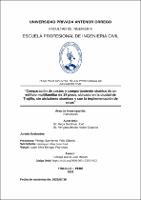| dc.contributor.advisor | Urteaga García, Juan Manuel | |
| dc.contributor.author | Vega Sandoval, Joel | |
| dc.contributor.author | Vergara Medina, Víctor Eduardo | |
| dc.creator | Vega Sandoval, Joel | |
| dc.date.accessioned | 2021-09-30T23:16:01Z | |
| dc.date.available | 2021-09-30T23:16:01Z | |
| dc.date.issued | 2021 | |
| dc.identifier.uri | https://hdl.handle.net/20.500.12759/8039 | |
| dc.description.abstract | La filosofía del aislamiento sísmico consiste en desacoplar una estructura de los
movimientos del suelo de tal manera que se logre reducir las solicitaciones
sísmicas que se producirían en la edificación ante eventual fenómeno de este
tipo. Este novedoso sistema es una técnica de diseño sismorresistente que
busca reducir la energía que entra a una estructura durante un movimiento
sísmico a través de colocar dispositivos muy flexibles horizontalmente entre la
cimentación y superestructura de esta.
Los aisladores sísmicos son elementos que poseen una gran rigidez a cargas
verticales, pero son flexibles lateralmente. Por lo tanto, las cargas transmitidas a
la estructura durante un evento sísmico severo generarán desplazamientos
alrededor de los 20 centímetros en la interface de aislación. No obstante, se
reducirían las derivas en la superestructura. Este sistema de aislamiento puede
ser utilizado como una estrategia para proteger una estructura de un sismo
Esta tesis se enfoca en la comparación de la aplicación de esta moderna técnica
de construcción frente a las construcciones que comúnmente se realizan en
nuestro país, y en especial en la ciudad de Trujillo. Para realizar este estudio nos
basamos en el uso de aisladores de tipo elastoméricos, los cuales están hecho
a base de caucho que le permite ser flexible lateralmente, y se combina con
planchas de acero para aumentar la rigidez vertical del elemento.
Al desarrollar esta investigación, se comprobó teóricamente que el
comportamiento sísmico de una estructura mejora significativamente, teniendo
como una de sus principales ventajas la reducción de los esfuerzos y
concentrando, además, la participación modal, a solo un modo por cada
dirección, haciendo que la superestructura trabaje como un cuerpo rígido y
reduciendo la incertidumbre del comportamiento sísmico.
En términos de costo, si bien concluimos que no representa una reducción
importante, sino por el contrario un incremento. Es necesario que en este análisis
se incluyan los costos que se producen por reparaciones y por cese de
operaciones de la edificación como una ventaja económica de este sistema. | es_PE |
| dc.description.abstract | The philosophy of seismic isolation consists in decoupling a structure from the
ground movements in such a way that it is possible to reduce the seismic stresses
that would occur in the building in the event of a possible phenomenon of this
type. This novel system is a seismic resistant design technique that seeks to
reduce the energy that enters a structure during a seismic movement through
placing highly flexible devices horizontally between the foundation and its
superstructure.
Seismic isolators are elements that have great rigidity at vertical loads, but are
laterally flexible. Therefore, the loads transmitted to the structure during a severe
seismic event will generate displacements around 20 centimeters at the isolation
interface. However, drifts in the superstructure would be reduced. This isolation
system can be used as a strategy to protect a structure from an earthquake.
This thesis focuses on comparing the application of this modern construction
technique against the constructions that are commonly carried out in our country,
and especially in the city of Trujillo. To carry out this study we based on the use
of elastomeric type insulators, which are made of rubber that allows it to be
laterally flexible, and it is combined with steel plates to increase the vertical rigidity
of the element.
When developing this research, it was theoretically proven that the seismic
behavior of a structure improves significantly, having as one of its main
advantages the reduction of efforts and, in addition, concentrating modal
participation, to only one mode for each direction, making the superstructure work
as a rigid body and reducing the uncertainty of seismic behavior.
In terms of cost, although we conclude that it does not represent a significant
reduction, but rather an increase. It is necessary to include in this analysis the
costs that occur for repairs and for the cessation of construction operations as an
economic advantage of this system | en_US |
| dc.description.uri | Tesis | es_PE |
| dc.format | application/pdf | es_PE |
| dc.language.iso | spa | es_PE |
| dc.publisher | Universidad Privada Antenor Orrego | es_PE |
| dc.relation.ispartofseries | T_CIVIL_1976 | |
| dc.rights | info:eu-repo/semantics/closedAccess | es_PE |
| dc.rights.uri | https://creativecommons.org/licenses/by/4.0/ | es_PE |
| dc.source | Universidad Privada Antenor Orrego | es_PE |
| dc.source | Repositorio Institucional - UPAO | es_PE |
| dc.subject | Costos | es_PE |
| dc.subject | Edificio | es_PE |
| dc.title | Comparación de costos y comportamiento sísmico de un edificio multifamiliar de 14 pisos, ubicado en la ciudad de Trujillo, sin aisladores sísmicos y con la implementación de estos | es_PE |
| dc.type | info:eu-repo/semantics/bachelorThesis | es_PE |
| thesis.degree.level | Título Profesional | es_PE |
| thesis.degree.grantor | Universidad Privada Antenor Orrego. Facultad de Ingeniería | es_PE |
| thesis.degree.name | Ingeniero Civil | es_PE |
| thesis.degree.discipline | Ingeniería Civil | es_PE |
| dc.subject.ocde | https://purl.org/pe-repo/ocde/ford#2.01.00 | es_PE |
| renati.advisor.orcid | https://orcid.org/0000-0001-5395-9432 | es_PE |
| renati.author.dni | 70753473 | |
| renati.author.dni | 71269145 | |
| renati.advisor.dni | 18181285 | |
| renati.type | https://purl.org/pe-repo/renati/type#tesis | es_PE |
| renati.level | https://purl.org/pe-repo/renati/level#tituloProfesional | es_PE |
| renati.discipline | 732016 | es_PE |
| renati.juror | Pérrigo Sarmiento, Félix Gilberto | |
| renati.juror | Henríquez Ulloa, Juan Paul | |
| renati.juror | Lujan Silva, Enrique Francisco | |
| dc.publisher.country | PE | es_PE |


